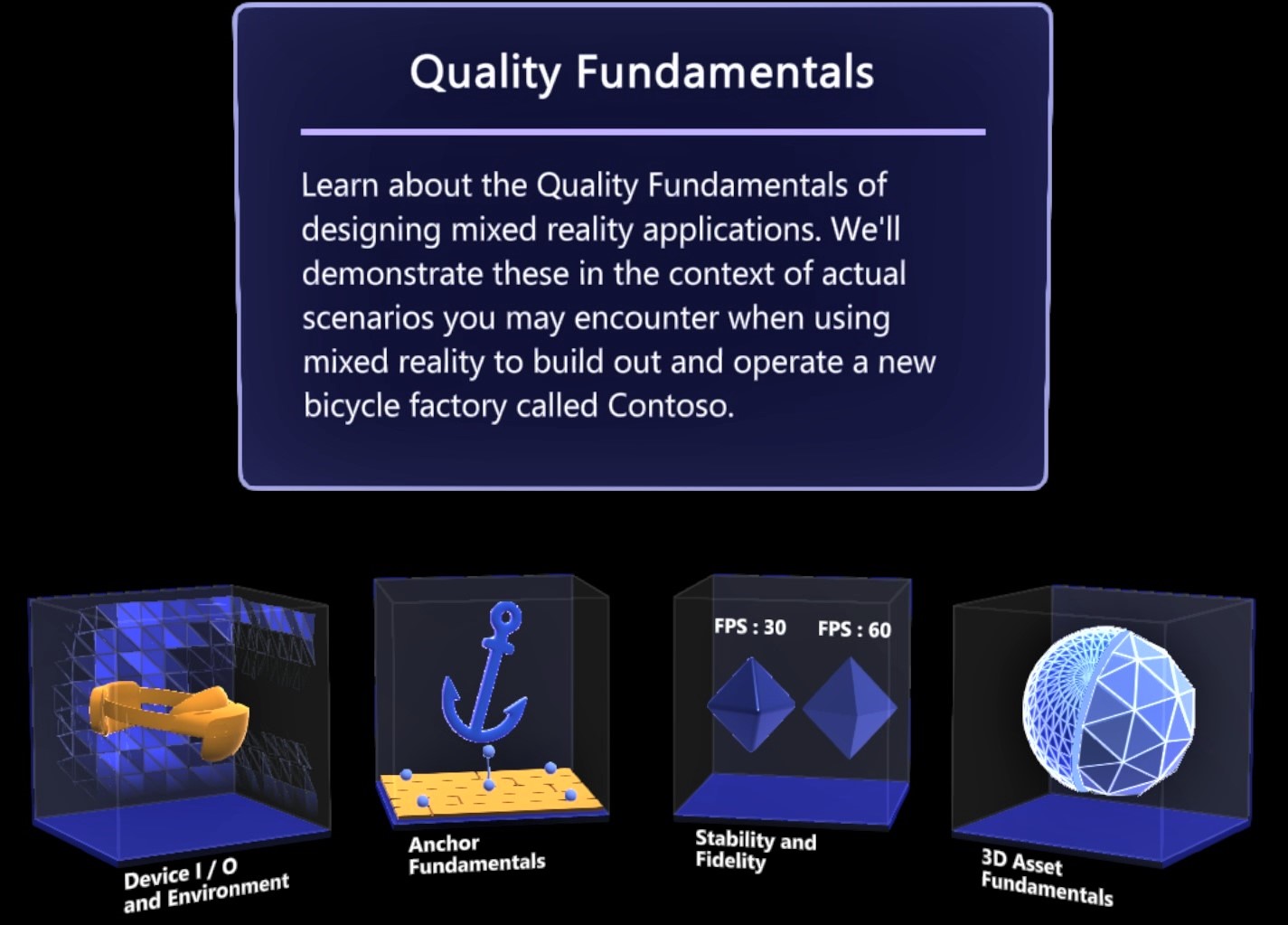Note
Access to this page requires authorization. You can try signing in or changing directories.
Access to this page requires authorization. You can try changing directories.
Quality Fundamentals is a HoloLens 2 app that demonstrates the fundamentals of building a great mixed reality experience. Instead of just learning and reading about quality issues in mixed reality, we can now experience common environmental, design, and performance issues and solutions firsthand by selecting the options provided in the app.
To download and install the app, go to the app download page:

In this sample app, we'll learn about:
- Device I/O and environment: How the environmental factors can affect HoloLens' performance.
- Spatial Anchors: How to align holograms to a physical space by using spatial anchors.
- Holographic stability and fidelity: Explore techniques to help improve the stability and fidelity of Holograms.
- 3D asset fundamentals: How to optimize 3D assets to maintain high visual fidelity.
Device I/O and environment
Start the Quality Fundamentals app on HoloLens. Once the app's homepage appears, select Device I/O and Environment. We'll explore how the HoloLens sensors and the surrounding environment affect spatial mapping, tracking and the placement of holograms.
Surfaces
Mirrors or surfaces with mirrored finishes can confuse the HoloLens sensors about the shape of the object. Objects reflected on the surface may be interpreted by the device as changing environment, which can cause the device to lose tracking. If mirrored surfaces are causing challenges for HoloLens, consider adding a screen or closable blinds.
For more information, see surfaces in a space in HoloLens environment considerations.
Lighting
HoloLens performance can be negatively impacted by either very low or very bright light conditions. The tracking sensors on the HoloLens need around 500-1000 lux of light to operate optimally. You can use a luxmeter or mobile app to measure the amount of light in your space.
For more information, see lighting in HoloLens environment considerations.
Anchor fundamentals
To explore how to use Spatial Anchors to align holograms to a physical space, select Anchor Fundametals on the app's homepage.
In this part of the app, we'll explore the following user scenarios:
- What happens when no anchor is being applied to an object.
- When multiple Spatial Anchors are being used for a group of objects.
- Sharing a Spatial Anchor between multiple collaborators by using a QR code.
- Anchor placement for very large objects in a space.
For more information, see Spatial Anchors in the Mixed Reality documentation.
Stability and fidelity
On the application's homepage, select Stability and Fidelity to explore how to improve hologram stability.
We'll explore the following key concepts:
Frame rate
To provide the best hologram experience possible, application developers must maintain 60 frames per second (FPS). In this part of the app, toggle between different triangle count options to experience the difference with various frame rates.

For more information, see frame rate in the hologram stability article.
Late stage reprojection (LSR)
Reprojection is used to stabilize holograms as users move around their space. Try out the different reprojection options provided by this part of the app to see the difference in hologram quality.

For detailed information, see reprojection in the hologram stability article.
Z-fighting
Z-fighting occurs when the mixed reality application cannot discern which object is in front of the other. You'll notice flickering of the holographic objects as they fight for the same z-depth value. Experience the effects of z-fighting in the app by changing the placement of a holographic object, the logo on a bicycle in this case.

For detailed information about z-fighting, see enable depth buffer sharing in the recommended settings for Unity article.
Anti-aliasing
Anti-aliasing is a technique used to smooth jagged edges on curved lines and diagonals in holograms. In this part of the app, experience the affects of aliasing on displayed text and bicycle spokes.
3D asset fundamentals
On the application's homepage, select 3D Asset Fundamentals to explore how to optimize 3D assets to meet the frame rate requirement while maintaining high visual fidelity.
We'll explore the following key concepts:
Triangle count
Select the number and complexity of bicycle models to experience the visual difference based on FPS.

For more information, see asset creation process.
Shader passes
Select the number of bikes and different shader options to experience the visual difference based on FPS.

For more information, see MRTK Standard Shader.
Draw calls
Draw calls are resource-intensive calls to the graphics card. In this part of the app, experience the visual difference first hand, as the number of draw calls impact FPS.

See CPU-to-GPU performance recommendations.
Finale
Here, we can explore how many fully optimized bicycles can be displayed, and the level of fidelity possible given the optimization techniques.

Next steps
Explore other mixed reality sample scenarios: